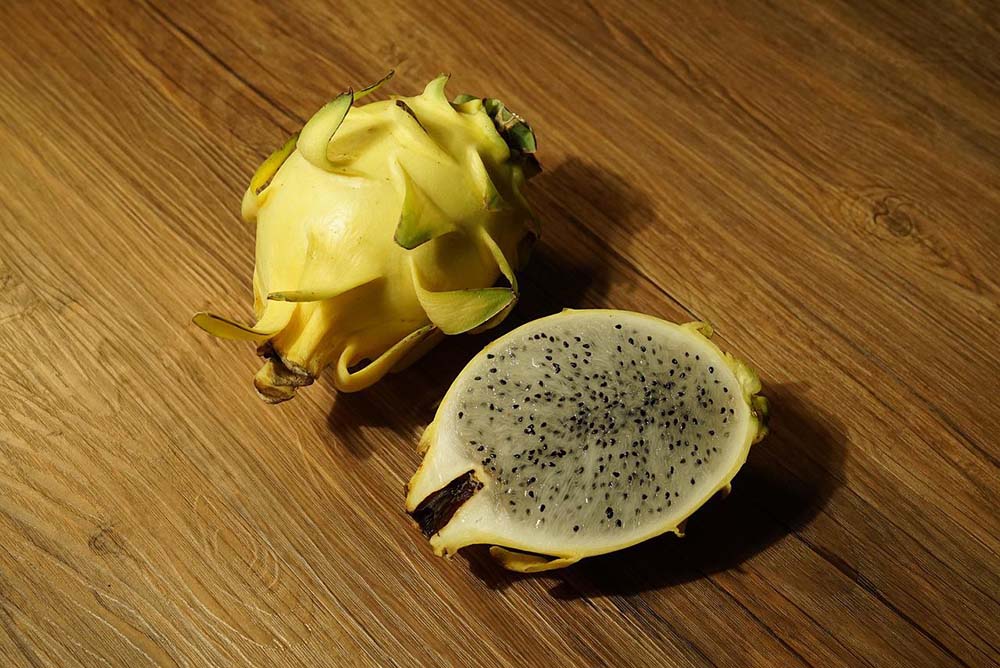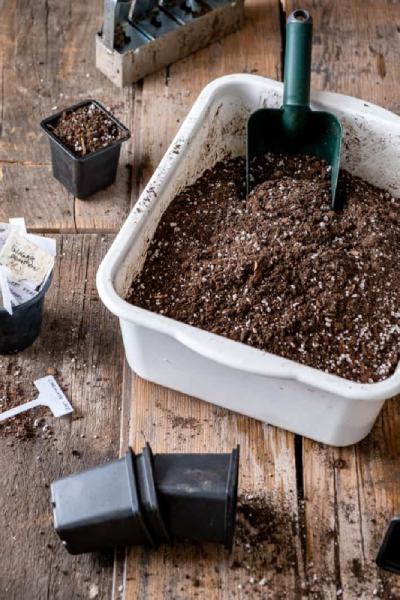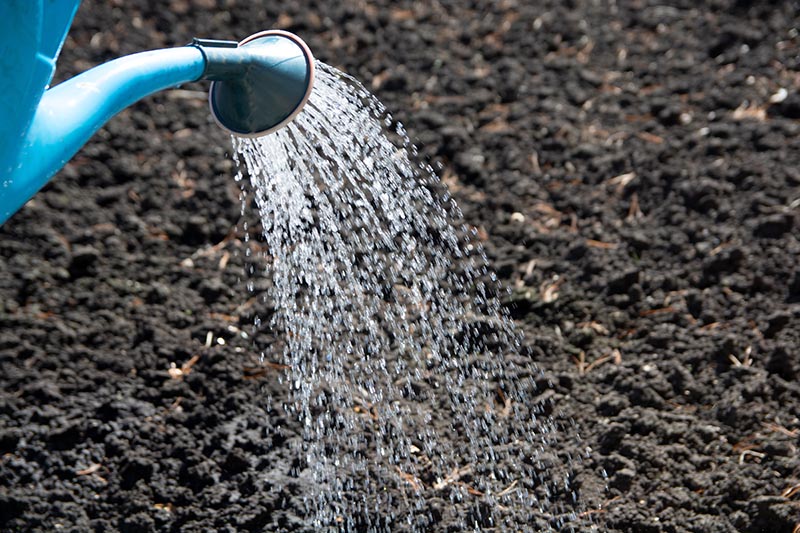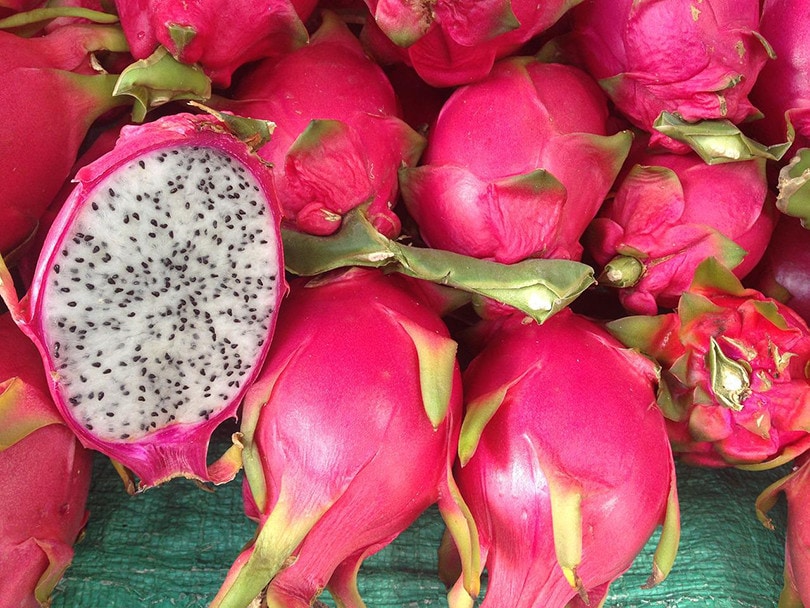How to Grow Dragon Fruit Indoors – 10 Tips, Tricks, and Guide
-

- Last updated:

Native to Central America and Mexico, the dragon fruit is known for its spikes, leather-like skin, and exotic flavor. It prefers organically rich and drained soil, full exposure to the sun, and flourishes in a hot climate. Can you grow it inside of a house, though? The answer is yes, you most certainly can.
As long as you follow our tips and tricks, you’ll be able to cultivate a beautiful pitaya garden indoors! In this guide, we’ll talk about how to pick the right pot for the dragon fruit, the best soil/fertilizer mix, watering, air circulation, pruning, and more. There’s nothing hard about this, and it will cost you almost nothing to grow the dragon fruit indoors!
| Botanical Name | Hylocereus undatus |
| Soil Type | Well-drained, organically rich, sandy |
| Soil PH | 6.0–7.0 (neutral) |
| Sun Exposure | Full sun (5–6 hours a day) |
| Watering Requirements | Low/moderate (once a week) |
| Temperature | 65–85º Fahrenheit |
| Hardiness Zone | 10–11 USDA |
| In Bloom | Early summer through mid-fall |
Before You Start: Pollination
If you want pitaya to bear edible fruit, you’ll need to pollinate it. Don’t worry; you won’t have to bring bees or bats into the house: hand-pollination with a paintbrush will work as well. You can buy the pollen at a dedicated store or get it from a fruit that you’re already growing outdoors. Be very gentle when collecting it from the flower and adding it to the stigma of the newly grown cactus.
A quick note: this plant blooms at night, which means it will only produce fruit if you fertilize it early in the morning (before the sun sets). The result will be well worth it, though, as the dragon fruit is equally delicious, nutritious, and looks quite stunning. Indoors, it needs a humid climate, relatively dry soil, and lots of sun exposure to grow.

Seeds vs Cuttings
To get started, cut a healthy dragon fruit, grab a couple of seeds, and plant them into the container. We do have to warn you, though, that dragon fruit grown from seeds takes 5–6 years to produce fruit. If you’re not very patient, consider growing it from cuttings. This way, when taken care of properly, you will be rewarded with delightful fruit in 1–2 years.
See that the stem is nice and large (ask a friend to give it to you or buy it from a local nursery). Give it a week or two to dry and only then plant it. And here are the species that have proven to thrive indoors. These varieties all taste differently and have unique colors, but they’re all a great choice for an indoor garden:
- Zamorano
- Yellow Dragon Fruit
- Edgar’s Baby
- Seoul Kitchen
- Alice
How to Grow Dragon Fruit Indoors
1. The Container Comes First
For starters, a 5–6-gallon container (10–15 inches in diameter) that’s 10- to 12-inches deep will be just right for this plant. As long as it’s got holes for drainage and air circulation, it will be able to support growth for 6–12 months. We recommend picking a pot that’s crafted from a heavy material, like ceramic. The reason: mature dragon fruit grows tall. On average, it reaches up to 20 feet in height.
So, the heavier the container the easier it will be for it to handle all that weight. Also, you might want to add a trellis. Pitaya is a climber, and without proper support, it won’t be able to hold its own fruit. To make the plant grow faster, add some slow-release fertilizer to the pot before planting the seeds. Covering the container with food storage plastic that’s got holes in it will also stimulate growth.

2. What About the Soil and the Fertilizer?
While the dragon fruit is classified as a cactus, it doesn’t always behave like one. So, when it comes to the soil, see that it’s organically rich, neutral/acidic (6.0–7.0), and sandy. Adding some sand and pebbles will improve the pot’s drainage capabilities, which is exactly what you want for the dragon fruit. Don’t have any of that? Then try putting bark or stones at the very bottom of the pot.
What about fertilization, though? Is it even necessary? Yes, you should add a healthy amount once a month. Go with low-nitrogen fertilizer: it has proven to be perfect for this plant. When there’s too much nitrogen in the soil, that leads to vegetative growth, and we don’t want that. As for the winter days, it’s usually not necessary to add any compost to the soil.
3. Watering: How Much is Enough?
This cactus isn’t a big fan of water. Make sure to feed it in small doses to avoid overwatering. This is a very common mistake among amateur indoor gardeners: they believe that the more they water their plants, the better. In summer, when the dragon fruit is growing rapidly, only water it when the soil (the top of it) is already dry. Put your finger in it to check how dry or wet the soil is.
When the first frost hits, cut back on the watering to avoid the plant going dormant. Normally, this happens in late/mid-fall or early winter.

4. Finding the Right Humidity Levels
For this plant, you won’t have to go for extreme humidity levels to help it flourish. The dragon fruit prefers below-average levels, 30%–50%. It can, of course, survive in slightly lower and higher humidity. Now, if you live in a dry area, and it’s a scorching-hot summer, a humidifier might be necessary. Pitaya is relatively resistant to dry conditions, thanks to the branches that retain water.
Still, if the air stays dry for long periods (like 7–10 days), it won’t last for long. Misting could also work, but only if you do it frequently. A tray with pebbles is another cheap solution; but it won’t be nearly as effective as a high-powered humidifier. Thankfully, you can get such a device for as low as $30–$50.
5. Exposure to the Sun/Light
To grow, thrive, and develop fruits, pitaya needs 6–8 hours of exposure to direct sunlight during the day. To get the best results, put the pot on a window facing east early in the morning and then move it to a west-facing windowsill during the evening. South-facing windows can be dangerous for this plant, though, as the light might be too strong and leave sunburn marks.
To avoid the fruit getting scorched, make a habit of rotating the container regularly. This should help solve the issue. But what if you live in a cloudy area with only 2–3 hours of sun? Then you should use artificial lighting. Look for full-spectrum LED lights. Again, to avoid burns, give the dragon fruit some time to adapt. Place the light 25–30 inches away on the first day and then slowly move it closer over a week or two.

6. The Temperature Comes Next
The temperature also plays a key role in the dragon fruit’s well-being. When it’s too low, the plant will wilt; and when it’s too high, it will have a hard time growing. The right temperature for it is 65–85ºF. Certain species can handle up to 85–90ºF; others can go on in temps as low as 50–55Fº. This isn’t a frost-resistant cactus, though, and will die at 30Fº. On top of that, it can’t survive at 100ºF.
7. Air Circulation and Pruning
Without air circulation, you’ll run the risk of fungi taking over pitaya and ruining it. When planted in organically-rich soil and watered adequately, this cactus grows rather quickly. That’s exactly why you have to thin it out once or twice a year, depending on the area that you live in. So, when is the right time to prune it? Are the flowers and leaves “taking over” the pot?
Then the plant needs to be cut! Yes, we know that the dragon fruit looks beautiful when it’s fully grown, but you still need to prune it. The side branches have to go as well. This way, you’ll be able to not only ensure proper air circulation but also make the fruits bigger and more nutritious. Do this in November, when the cactus is dormant, and the trimming won’t hurt it in any way.

8. Repotting: When Should You Do It?
The best time to move the dragon fruit to another container is before it is root-bound. This term is used to describe a situation when the roots of the plant have populated the entire pot and there’s no more space for them to grow in. If you let this go on for a while, the fruit will become weak and unhealthy, as the overabundance of roots will negatively affect pitaya’s ability to feed on the nutrients in the soil.
Now, depending on how big the original pot was, you might have to repot the dragon fruit in less than a year. Be very careful while you’re doing it, because this fruit’s roots are very small, thin, and fragile. It would be best to move it to a new container that’s at least 22–24-inches deep and 25–30-gallon big. This way, you won’t have to repot the cactus again next year.
9. Moving It Outdoors
If you want to cultivate steady growth, consider moving the dragon fruit plant outdoors for the summer. The right time for this will be when the danger of frost is gone and the temperature during the day is well above 70ºF. If the container is big enough, you can just put it on the patio or the porch. We would recommend putting it in the ground, though, because this way, it will grow even faster.
And when the daytime temps go below 65–70ºF, bring the cactus back in. Oh, and do remember that above-average temperatures (100ºF+) are hazardous for pitaya. In any case, you should water it more frequently when planted outdoors. To harvest this fruit, wait until it’s ripe (bright pink) and cut it from the stalk using scissors or a knife.

10. Keeping Diseases Away
The most common disease that affects the dragon fruit is Botryosphaeria dothidea (a type of fungus). If you notice blotchy spots on the plant (the stems, to be exact), that means it’s time to act. Trimming all the affected parts of the cactus should solve the issue. Sunburns are another widespread problem that makes pitaya peel. As mentioned, turning it regularly will help. If you’re too late, again, use the cutting technique.
That’s pretty much it for the diseases. The dragon fruit isn’t affected by any rare, hard-to-treat pathogens, and that’s good news.
Is the Dragon Fruit Nutritious?
On the inside, this fruit is white and fleshy (tastes something like kiwi and pears; that’s why it’s also known as the strawberry pear), with edible black seeds (they have a nutty flavor). The dragon fruit is high in minerals, vitamins, and antioxidants and is considered a healthy food. It’s rich in fiber, too, and is practically fat-free, which makes it a great snack if you’re on a diet and still want something mildly sweet.
Pitaya has also proven to lower blood sugar, boost the number of prebiotics in one’s body, and help the immune system. For most of us, it is 100% safe to eat but can cause allergic reactions in a very small group of people. We’re talking about vomiting, tongue swelling, and even hives. And one more thing: if you eat too much pitaya in a day, your pee will turn pink for a while, but this is totally normal.

Is It Dangerous for Pets?
No, the dragon fruit is absolutely safe for cats and dogs. It is not toxic and won’t cause any nausea, vomiting, or other health issues if your pet eats it. In fact, many dogs like eating dragon fruit, and for them, it will be just as healthy of a snack as it is for humans. Vitamin C, iron, magnesium, and omega-3 acids are all vital for any pet’s nutrition. So, yes, this fruit will be an excellent addition to their diet.
And don’t worry about the seeds: in contrast to most fruit seeds that can be harmful to dogs, that won’t be a problem with pitaya. Now, in some rare cases, eating too much of this fruit can cause an upset stomach or minor problems with digestion. So, keep an eye on your pet’s behavior to see whether this delicious treat is good for them, or not.
Conclusion
The dragon fruit is quite an exciting addition to any indoor garden. The beautiful colors, eye-grabbing spikes, and the lovely taste turn it into a crowd-pleaser. And, despite its exotic nature, this fruit isn’t at all difficult to grow indoors. True, it does require exposure to the sun, a certain temperature, rich soil, and proper air circulation.
But if you know your way around plants, vegetables, and fruits, and are ready to follow instructions, this will be a walk in the park. A little bit of patience and consistency is all you’ll need to see dragon fruit thrive and flourish on the windowsill in your bedroom! Once it’s fully grown, you can add it to your drinks and beverages!
- Dragon Fruit Medical Review
- ASPCA – Pitaya
- All About Dragon Fruit: 3 Health Benefits
- Hylocereus undatus (dragon fruit)
- Pitaya Growing in the Florida Home Landscape
- 7 Great Reasons to Add Dragon Fruit to Your Diet
- Can Dogs Eat Dragon Fruit
- Can Cats Eat Dragon Fruit? What You Need to Know!
- How to Grow Dragon Fruit Indoors: Pitaya Plant Growth Guide
- How to Easily Grow Dragon Fruit Indoors
- Dragon Fruit Growing Tips, Techniques, Ideas, and Secrets
Featured Image Credit: EugeneEdge, Shutterstock
Contents

